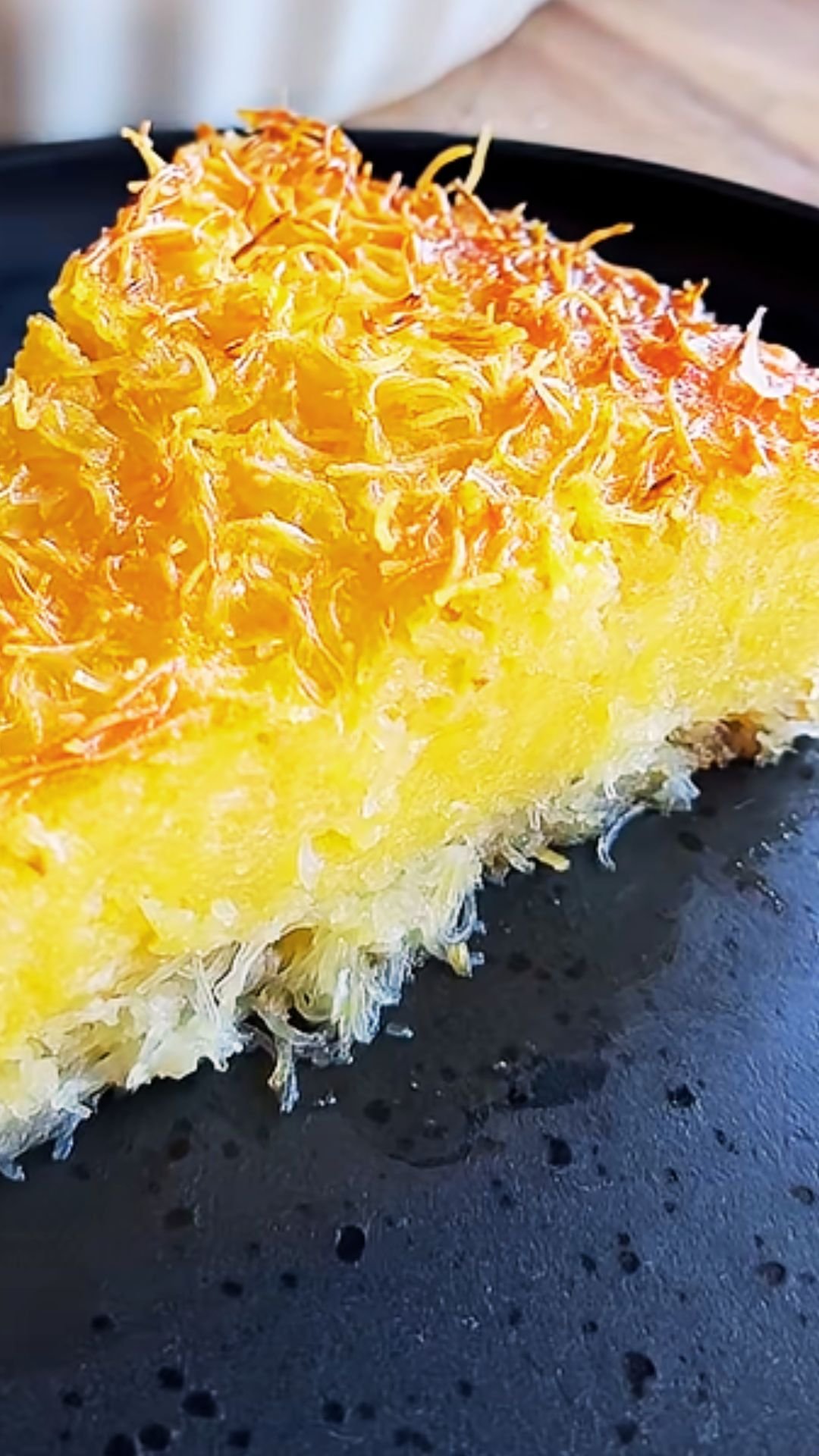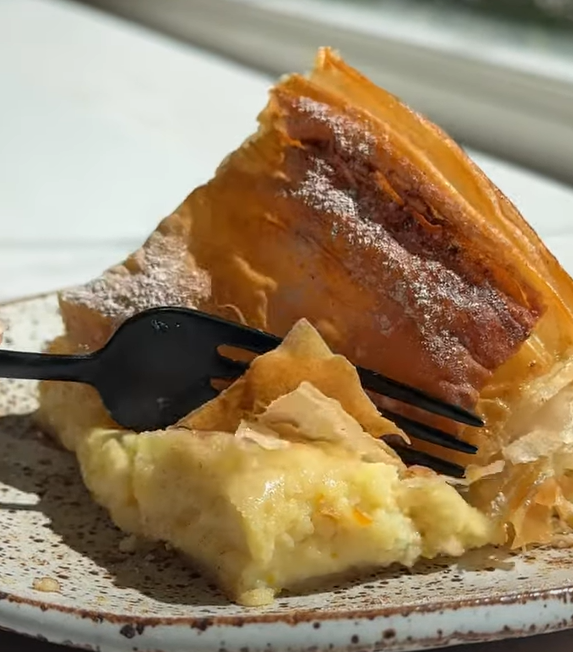There’s something magical that happens when I walk into my kitchen and catch the lingering scent of orange zest and warm spices from yesterday’s baking session. It instantly transports me back to my first encounter with Portokalopita in a small taverna overlooking the Aegean Sea. The proprietor, a warm-hearted Greek grandmother named Maria, served me a slice of this extraordinary orange cake that was so moist and flavorful, I knew I had to learn her secrets.
Portokalopita, which literally translates to “orange pie” in Greek, is far more than just a dessert – it’s a celebration of Mediterranean flavors, a testament to the ingenuity of Greek home cooks, and a perfect example of how simple ingredients can create something truly extraordinary. What makes this cake particularly special is its unique preparation method using phyllo pastry and its generous soaking in aromatic orange syrup.
Understanding the Essence of Portokalopita
Portokalopita: A traditional Greek dessert cake made with shredded phyllo pastry, fresh oranges, and eggs, baked until golden and then soaked in a fragrant orange syrup.
Phyllo Pastry: Ultra-thin sheets of unleavened dough that become crispy when baked, providing texture and structure to the cake.
Orange Syrup: A sweet, aromatic mixture of sugar, water, and fresh orange juice that penetrates the cake, creating its signature moist texture.
Semolina: Coarse wheat flour that adds body and a slightly grainy texture to the cake batter.
Unlike traditional butter-based cakes, Portokalopita relies on olive oil for its fat content, which not only makes it lighter but also adds a subtle Mediterranean flavor that complements the orange beautifully. The genius of this dessert lies in its method – the phyllo pastry is torn into pieces and mixed directly into the batter, creating irregular pockets of texture that absorb the syrup magnificently.
The Cultural Significance and Origins
My research into this beloved dessert revealed fascinating insights into its cultural importance. Portokalopita originated in the Greek islands, where orange trees flourish in the Mediterranean climate. Island cooks, known for their resourcefulness, developed this recipe as a way to use up phyllo pastry that might have become too dry for traditional savory pies.
The cake holds special significance during Greek Orthodox celebrations, particularly during the period leading up to Lent when eggs and dairy are still permitted in the diet. Many Greek families have their own cherished variations, passed down through generations, with subtle differences in spice combinations or syrup preparations.
What I find particularly endearing about Portokalopita is how it embodies the Greek philosophy of philoxenia – the love of strangers. This cake is almost always made in large quantities, meant to be shared with neighbors, friends, and unexpected visitors. It’s a dessert that brings people together, much like the communal spirit that defines Greek culture.
Essential Ingredients and Their Roles
Creating an authentic Portokalopita requires understanding not just what goes into it, but why each ingredient matters. Let me share the secrets I’ve learned about selecting and preparing these components.
The Orange Foundation
The star of this dessert is, undoubtedly, the orange. I’ve experimented with various types over the years, and I can confidently say that the variety you choose will significantly impact the final result. Naval oranges provide excellent juice content and moderate acidity, while Valencia oranges offer a more intense flavor profile. Greek cooks traditionally use bitter oranges when available, which add complexity but can be challenging to find outside the Mediterranean.
For the best results, I recommend using organic oranges whenever possible. You’ll be using both the juice and the zest, so avoiding pesticide residues is important. The zest should be finely grated, capturing only the colorful outer layer while avoiding the bitter white pith underneath.
The Phyllo Factor
Working with phyllo pastry initially intimidated me, but I’ve learned that for Portokalopita, perfection isn’t necessary. In fact, the rustic nature of torn phyllo pieces adds to the cake’s charm. The key is ensuring the phyllo isn’t too dry or too moist when you incorporate it into the batter.
I prefer to remove the phyllo from the freezer about two hours before baking, allowing it to thaw completely. If the sheets seem particularly dry, I lightly sprinkle them with water and cover with a damp towel for 15-20 minutes before tearing them into irregular pieces about the size of a business card.
Oil Selection and Quality
The choice of oil profoundly affects both flavor and texture. While many recipes call for neutral vegetable oil, I strongly advocate for using extra virgin olive oil. The key is selecting a mild, fruity variety rather than a robust, peppery one that might overpower the delicate orange flavors.
Greek olive oil would be ideal, but any high-quality extra virgin olive oil will work beautifully. I’ve found that oils from Spain’s Picual olives or Italy’s Frantoio olives complement the orange flavors exceptionally well.
Detailed Ingredient Breakdown
| Ingredient | Quantity | Quality Notes | Substitution Options |
|---|---|---|---|
| Fresh Orange Juice | 1 cup | Freshly squeezed, room temperature | No substitutes recommended |
| Orange Zest | 3 large oranges | Organic preferred, finely grated | Lemon zest (reduce by half) |
| Phyllo Pastry | 1 package (1 lb) | Thawed completely, not dried out | Puff pastry (different texture) |
| Extra Virgin Olive Oil | 3/4 cup | Mild, fruity variety | Neutral oil (less flavor) |
| Large Eggs | 6 whole | Room temperature | No substitutes |
| Granulated Sugar | 1 cup | Fine granulated works best | Caster sugar |
| Semolina Flour | 1/2 cup | Fine or medium grind | All-purpose flour |
| Baking Powder | 2 teaspoons | Fresh, not expired | No substitutes |
| Vanilla Extract | 1 teaspoon | Pure vanilla only | Vanilla paste |
| Ground Cinnamon | 1/2 teaspoon | Freshly ground preferred | Pre-ground acceptable |
Syrup Components and Preparation
| Syrup Ingredient | Quantity | Preparation Notes | Flavor Impact |
|---|---|---|---|
| Granulated Sugar | 1.5 cups | Dissolve completely | Primary sweetness |
| Water | 1 cup | Filtered preferred | Base liquid |
| Fresh Orange Juice | 1/2 cup | Strain if pulpy | Citrus enhancement |
| Orange Zest | 1 orange | Large strips | Aromatic oils |
| Cinnamon Stick | 1 whole | Break slightly | Warm spice note |
| Whole Cloves | 3-4 pieces | Remove before serving | Subtle complexity |
| Honey | 2 tablespoons | Greek honey preferred | Floral sweetness |
Step-by-Step Preparation Method
Preparing Your Kitchen and Equipment
Before beginning, I always ensure my kitchen is properly set up. This cake requires simultaneous preparation of multiple components, so organization is crucial. I use a large mixing bowl for the batter, a medium saucepan for the syrup, and ensure my 9×13 inch baking dish is clean and ready for greasing.
The key to success lies in timing – the syrup should be ready when the cake comes out of the oven, as the absorption is most effective when both are warm.
Creating the Perfect Batter
I begin by preheating my oven to 350°F (175°C) and greasing my baking dish with a light coating of olive oil. In my large mixing bowl, I whisk together the eggs until they’re well combined but not frothy. The goal is incorporation, not aeration.
Next, I gradually add the sugar, whisking continuously until the mixture becomes pale and slightly thickened. This usually takes about 3-4 minutes of steady whisking. I then incorporate the olive oil in a slow, steady stream while continuing to whisk, creating a smooth emulsion.
The orange juice and zest come next, whisked in until fully incorporated. I can already smell the bright, citrusy aroma that promises great things to come. In a separate bowl, I combine the semolina flour, baking powder, and cinnamon, whisking to eliminate any lumps before folding this dry mixture into the wet ingredients.
Incorporating the Phyllo

This step initially seemed daunting, but I’ve learned to embrace the rustic nature of the process. I tear the phyllo sheets into irregular pieces, roughly 2-3 inches in size. Don’t worry about uniformity – the varied sizes actually contribute to the cake’s interesting texture.
I add the torn phyllo to the batter gradually, folding gently with a large spoon or spatula. The phyllo will absorb some of the liquid immediately, and the mixture will look somewhat lumpy and irregular. This is exactly what you want – resist the urge to overmix, as this can make the phyllo tough.
Baking to Golden Perfection
I pour the mixture into my prepared baking dish, spreading it evenly but not smoothing the top completely. The irregular surface will create lovely golden peaks and valleys as it bakes.
The cake bakes for 45-50 minutes, until the top is golden brown and a toothpick inserted in the center comes out with just a few moist crumbs. The kitchen fills with the most incredible aroma – orange, cinnamon, and that distinctive smell of phyllo browning in the oven.
Crafting the Aromatic Syrup
While the cake bakes, I prepare the syrup. In my medium saucepan, I combine the sugar, water, orange juice, orange zest strips, cinnamon stick, and cloves. I bring this mixture to a boil over medium-high heat, stirring until the sugar completely dissolves.
Once boiling, I reduce the heat to medium-low and simmer for 10-12 minutes, until the syrup has thickened slightly and the flavors have melded beautifully. I remove it from heat and stir in the honey, then strain out the whole spices and zest strips. The syrup should be warm but not boiling when applied to the cake.
The Critical Syrup Application
This moment is crucial for achieving the perfect texture. As soon as the cake comes out of the oven, while it’s still hot, I slowly pour the warm syrup over the entire surface. I use a large spoon to ensure even distribution, paying special attention to the edges where the syrup might pool.
The sizzling sound as the syrup meets the hot cake is music to my ears – it means the absorption process is working perfectly. I watch as the golden surface gradually absorbs the liquid, creating a glossy, moist appearance that promises incredible flavor.
Perfecting Your Technique
Temperature Control Mastery
| Stage | Temperature | Duration | Visual Cues |
|---|---|---|---|
| Oven Preheating | 350°F (175°C) | 15-20 minutes | Fully heated |
| Baking | 350°F (175°C) | 45-50 minutes | Golden brown top |
| Syrup Preparation | Medium-high to simmer | 12-15 minutes | Light amber color |
| Cooling Period | Room temperature | 2-3 hours | Syrup fully absorbed |
Troubleshooting Common Issues
Through years of making Portokalopita, I’ve encountered and solved various challenges. If your cake seems too dry after cooling, the phyllo may have been over-dried, or the syrup might have been too cool when applied. For future attempts, ensure the phyllo has proper moisture content and apply the syrup while both cake and syrup are warm.
If the cake appears soggy or the bottom becomes mushy, the syrup was likely too thin or applied too quickly. The solution is to simmer the syrup longer for proper consistency and pour it slowly, allowing gradual absorption.
Achieving the Perfect Texture Balance
The ideal Portokalopita should have a moist, tender crumb with distinct phyllo pieces that provide textural interest without being tough or chewy. The syrup should penetrate throughout without making the cake soggy or overly sweet.
I’ve found that the key lies in the phyllo preparation and syrup consistency. The phyllo should be pliable but not wet, and the syrup should coat a spoon lightly when ready – not too thin that it runs off immediately, but not so thick that it doesn’t penetrate the cake.
Variations and Regional Adaptations
Island Variations I’ve Discovered
During my travels through the Greek islands, I encountered fascinating regional variations of Portokalopita. On Crete, local bakers add a touch of mastiha (mastic resin) to the syrup, creating a unique pine-like flavor that’s surprisingly complementary to the orange. In Rhodes, some recipes include a small amount of ground almonds in the batter, adding richness and subtle nuttiness.
The Ionian islands often feature a version with bergamot zest when available, creating a more complex citrus profile reminiscent of Earl Grey tea. These variations remind me that traditional recipes are living documents, adapted by each cook to local ingredients and family preferences.
Modern Adaptations I’ve Developed
For friends with dietary restrictions, I’ve successfully created variations that maintain the essence while accommodating different needs. A gluten-free version using almond flour instead of semolina works surprisingly well, though the texture is slightly denser. For those avoiding refined sugar, I’ve experimented with coconut sugar and pure maple syrup with good results.
I’ve also developed a mini version baked in individual ramekins, perfect for dinner parties. These personal-sized cakes bake in about 25-30 minutes and create an elegant presentation when unmolded and served with a dollop of Greek yogurt.
Serving Suggestions and Accompaniments
Traditional Presentation Methods
In Greece, Portokalopita is typically served at room temperature, cut into generous squares or diamonds. The traditional accompaniment is strong Greek coffee and perhaps a small glass of cold water. During special occasions, it might be served with a small scoop of vanilla ice cream or a dollop of thick Greek yogurt drizzled with honey.
I’ve learned that the cake actually improves after resting for several hours or even overnight, as the flavors meld and the syrup distributes more evenly throughout. This makes it an excellent make-ahead dessert for entertaining.
Creative Modern Pairings
While respecting tradition, I’ve discovered some wonderful modern accompaniments. A light dusting of powdered sugar just before serving adds visual appeal, and I sometimes garnish with candied orange peel that I make using the leftover orange rinds.
For special occasions, I serve it alongside mascarpone cheese lightly sweetened with honey and vanilla, or with a small portion of lemon sorbet that provides a refreshing contrast to the rich, sweet cake. Fresh berries, particularly strawberries or raspberries, offer both color contrast and flavor balance.
Beverage Pairings That Enhance the Experience
The traditional pairing with Greek coffee remains my favorite, as the bitter coffee balances the sweet cake perfectly. However, I’ve found that herbal teas, particularly chamomile or orange blossom tea, create lovely flavor harmonies.
For afternoon serving, a light black tea or even green tea with jasmine works beautifully. The key is avoiding beverages that compete with the orange flavor rather than complementing it.
Storage and Longevity
Proper Storage Techniques
One of Portokalopita’s greatest advantages is its excellent keeping quality. I store mine covered at room temperature, where it remains fresh and delicious for up to five days. The syrup acts as a natural preservative, keeping the cake moist without refrigeration.
If you need to store it longer, refrigeration is acceptable, though I prefer to bring it back to room temperature before serving for the best flavor and texture. The cake can be frozen for up to three months, though I recommend freezing individual portions wrapped in plastic wrap and aluminum foil for convenience.
Quality Changes Over Time
Interestingly, I’ve found that Portokalopita’s flavor actually develops and improves over the first 24-48 hours after baking. The spices in the syrup penetrate more deeply, and the overall flavor becomes more integrated and complex. This makes it an ideal dessert to prepare a day ahead of serving.
Nutritional Considerations and Dietary Adaptations
Understanding the Nutritional Profile
| Nutrient | Per Serving (1/12 of recipe) | Daily Value % |
|---|---|---|
| Calories | 385 | 19% |
| Total Fat | 16g | 21% |
| Saturated Fat | 2.5g | 13% |
| Cholesterol | 95mg | 32% |
| Sodium | 125mg | 5% |
| Total Carbohydrates | 58g | 21% |
| Dietary Fiber | 2g | 7% |
| Sugars | 45g | – |
| Protein | 7g | 14% |
| Vitamin C | 35mg | 39% |
| Calcium | 85mg | 6% |
Health Benefits of Key Ingredients
The olive oil in Portokalopita provides beneficial monounsaturated fats and vitamin E, while the fresh oranges contribute significant vitamin C and flavonoids. The eggs add high-quality protein and various B vitamins. While this is certainly a treat rather than health food, it does offer some nutritional benefits alongside its indulgent pleasure.
The semolina flour provides more protein and fiber than regular all-purpose flour, and the spices contribute antioxidants and anti-inflammatory compounds. When enjoyed in moderation as part of a balanced diet, Portokalopita can be a satisfying dessert that doesn’t completely derail healthy eating goals.
Frequently Asked Questions
Q: Can I make Portokalopita ahead of time for a party?
Absolutely! In fact, I recommend making it at least a day ahead. The flavors improve significantly after the cake has time to absorb the syrup completely, and it eliminates any last-minute preparation stress. I often make it two days before serving for optimal flavor development.
Q: What should I do if my phyllo pastry seems too dry or brittle?
If your phyllo feels overly dry, lightly mist the sheets with water using a spray bottle, then cover with a slightly damp towel for 15-20 minutes. This will restore enough moisture to make the sheets pliable without making them soggy. Phyllo that’s too brittle will break into dust rather than tearing into useful pieces.
Q: Can I reduce the amount of sugar in the recipe?
While you can reduce the sugar somewhat, I don’t recommend cutting it by more than 25% as it affects both flavor and texture. The sugar in the cake provides structure, and the syrup sugar helps with preservation. If you want less sweetness, try reducing the syrup sugar rather than the cake sugar, or serve smaller portions.
Q: Why did my cake turn out soggy on the bottom?
A soggy bottom usually results from applying the syrup too quickly or when the syrup is too thin. Make sure to simmer the syrup until it lightly coats a spoon, and pour it slowly over the hot cake, allowing each addition to absorb before adding more. Also ensure your baking dish isn’t too deep, which can cause uneven absorption.
Q: Can I freeze individual portions of Portokalopita?
Yes, individual portions freeze beautifully for up to three months. I wrap each piece in plastic wrap, then aluminum foil, and label with the date. Thaw at room temperature for about 2 hours before serving. The texture remains remarkably good after freezing.
Q: What’s the best way to cut clean, neat squares?
I use a sharp knife dipped in warm water and wiped clean between cuts. The syrup can make the cake slightly sticky, so the warm, clean knife helps create neat edges. Some people prefer to chill the cake slightly before cutting, which can also help with clean slices.
Q: Can I use bottled orange juice instead of fresh?
While fresh juice is always preferable for the best flavor, high-quality, not-from-concentrate orange juice can work in a pinch. However, avoid juice with added sugars or artificial flavors, as these will negatively impact the final result. The fresh orange zest is absolutely essential and cannot be substituted.
Q: How do I know when the syrup has reached the right consistency?
The syrup is ready when it lightly coats the back of a spoon and has reduced by about one-third from its original volume. It should flow freely but have more body than water. If you drop a small amount on a cold plate, it should hold its shape briefly before spreading.
This magnificent cake represents everything I love about Greek baking – the ingenious use of simple ingredients, the generous spirit of sharing, and the way food connects us to culture and memory. Every time I make Portokalopita, I’m reminded of that first taste in Maria’s taverna and the warm hospitality that defines Greek culture. Whether you’re making it for a special occasion or simply to bring a taste of the Mediterranean to your everyday life, this cake promises to create its own special memories in your kitchen and around your table.


